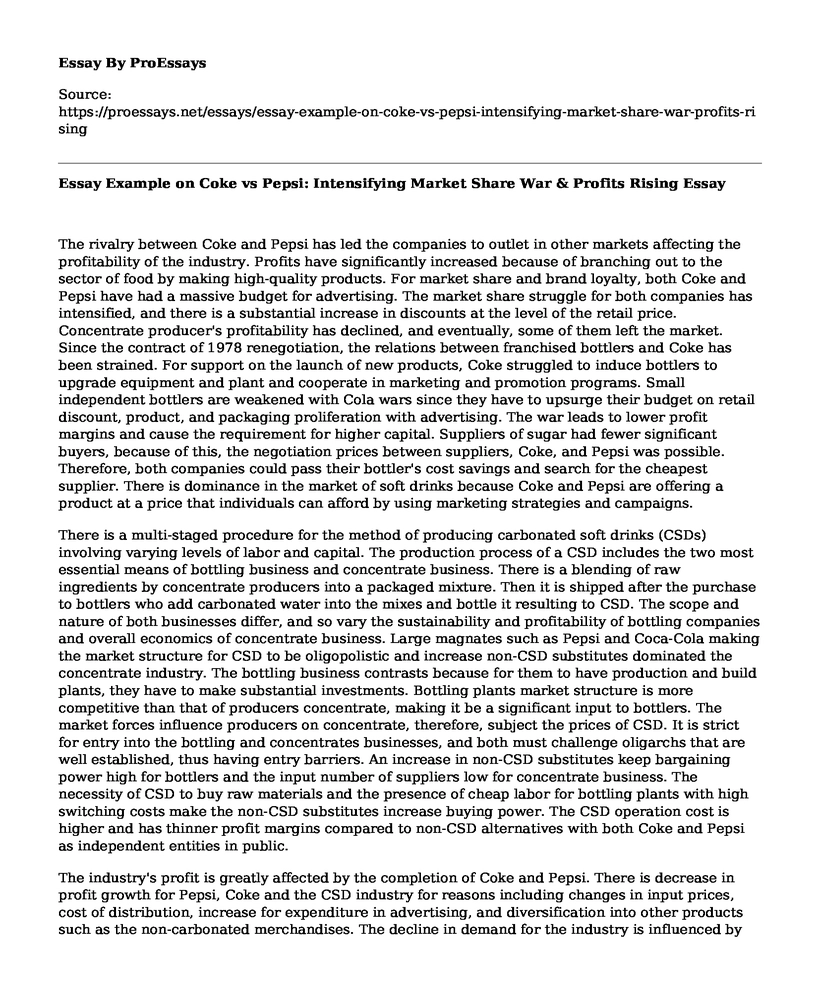The rivalry between Coke and Pepsi has led the companies to outlet in other markets affecting the profitability of the industry. Profits have significantly increased because of branching out to the sector of food by making high-quality products. For market share and brand loyalty, both Coke and Pepsi have had a massive budget for advertising. The market share struggle for both companies has intensified, and there is a substantial increase in discounts at the level of the retail price. Concentrate producer's profitability has declined, and eventually, some of them left the market. Since the contract of 1978 renegotiation, the relations between franchised bottlers and Coke has been strained. For support on the launch of new products, Coke struggled to induce bottlers to upgrade equipment and plant and cooperate in marketing and promotion programs. Small independent bottlers are weakened with Cola wars since they have to upsurge their budget on retail discount, product, and packaging proliferation with advertising. The war leads to lower profit margins and cause the requirement for higher capital. Suppliers of sugar had fewer significant buyers, because of this, the negotiation prices between suppliers, Coke, and Pepsi was possible. Therefore, both companies could pass their bottler's cost savings and search for the cheapest supplier. There is dominance in the market of soft drinks because Coke and Pepsi are offering a product at a price that individuals can afford by using marketing strategies and campaigns.
There is a multi-staged procedure for the method of producing carbonated soft drinks (CSDs) involving varying levels of labor and capital. The production process of a CSD includes the two most essential means of bottling business and concentrate business. There is a blending of raw ingredients by concentrate producers into a packaged mixture. Then it is shipped after the purchase to bottlers who add carbonated water into the mixes and bottle it resulting to CSD. The scope and nature of both businesses differ, and so vary the sustainability and profitability of bottling companies and overall economics of concentrate business. Large magnates such as Pepsi and Coca-Cola making the market structure for CSD to be oligopolistic and increase non-CSD substitutes dominated the concentrate industry. The bottling business contrasts because for them to have production and build plants, they have to make substantial investments. Bottling plants market structure is more competitive than that of producers concentrate, making it be a significant input to bottlers. The market forces influence producers on concentrate, therefore, subject the prices of CSD. It is strict for entry into the bottling and concentrates businesses, and both must challenge oligarchs that are well established, thus having entry barriers. An increase in non-CSD substitutes keep bargaining power high for bottlers and the input number of suppliers low for concentrate business. The necessity of CSD to buy raw materials and the presence of cheap labor for bottling plants with high switching costs make the non-CSD substitutes increase buying power. The CSD operation cost is higher and has thinner profit margins compared to non-CSD alternatives with both Coke and Pepsi as independent entities in public.
The industry's profit is greatly affected by the completion of Coke and Pepsi. There is decrease in profit growth for Pepsi, Coke and the CSD industry for reasons including changes in input prices, cost of distribution, increase for expenditure in advertising, and diversification into other products such as the non-carbonated merchandises. The decline in demand for the industry is influenced by public sentiment change towards highly sugary drinks, therefore causing a decrease in the need for carbonated products that are sugary. Throughout the years, the purchasing power has increased with large food retailer's negotiation power altering the profits and long stand of Cola business like Wal-Mart. A combination increase in large retailers buying power and inability to increment prices weaken the profits and revenue for cola establishments. New manufacturing costs are added because of substitute beverages and diversified the risk depend on carbonated cola. Traditional beverages demand for Coke and Pepsi are affected dramatically by substitutes, such as a reduced amount of sugary drinks like Lipton Iced Tea and energy drinks like Gatorade. A more health-conscious public makes the Cola industry introduce alternatives, but these substitutes make lower sales even with high-profit margins than carbonated sodas. In the search for a replacement, the rivalry between Coke and Pepsi heightens the costs of new advertising and new fixed production expenses for other non-carbonated products.
Work Cited
Yoffie, David B. Cola wars continue: Coke and Pepsi in the twenty-first century. Harvard Business School, 2002.
Cite this page
Essay Example on Coke vs Pepsi: Intensifying Market Share War & Profits Rising. (2023, May 23). Retrieved from https://proessays.net/essays/essay-example-on-coke-vs-pepsi-intensifying-market-share-war-profits-rising
If you are the original author of this essay and no longer wish to have it published on the ProEssays website, please click below to request its removal:
- The Relationship Between Bill Gate's Windows
- The Most Advanced/Interesting Computer Application - Essay Sample
- Essay on Nike's Gender Pay Gap: Lawsuit Implications & Analysis
- Essay on SOUQ: World's Biggest E-Commerce Company in Arab Region
- Coca-Cola's Secret to Success: Innovating with Technology - Essay Sample
- Uber: The Global Mobility Giant Changing Lives - Essay Sample
- The iPhone Marketing - Report Sample







